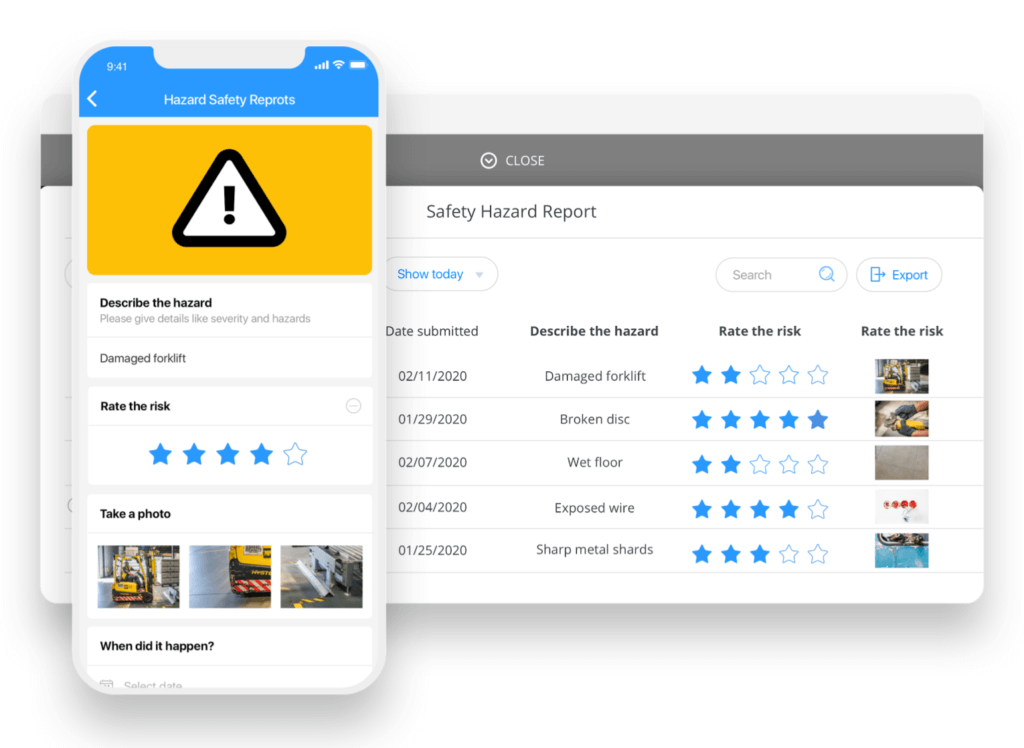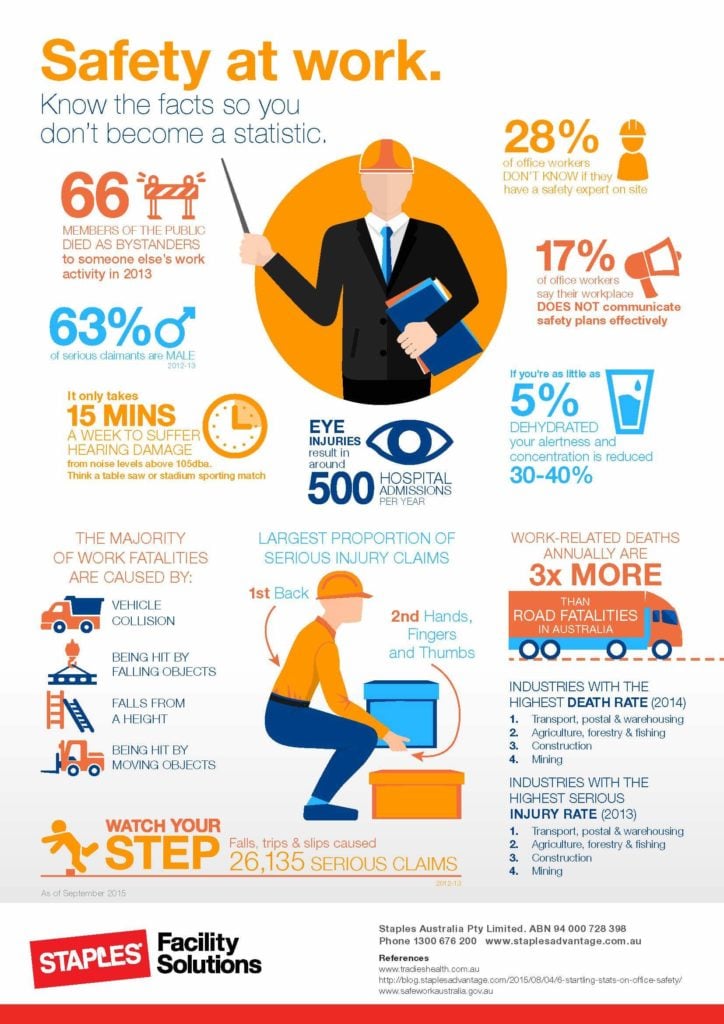Every small business has workplace risks. That’s true whether your job puts you 30 stories in the air or keeps you at a desk for most of the day. Luckily, you can put systems in place to reduce your exposures, and your employee training program is the perfect place to start.
Employee training is your chance to build risk management into the very fiber of your business. It gives your staff, customers and ultimately your business, the tools they need to protect themselves. Using the right tools and technology will also help to streamline your onboarding and risk management, making it easier to implement risk and hazard regulations.
So how exactly can your company benefit from a training program? Among many other reasons, a training program helps you reduce the chance of employee injuries, customer injuries and customer disputes.
Decrease Work Injuries
The Occupational Safety and Health Administration (OSHA) reports that more than 4 million workers suffer a serious on-the-job illness or injury every year. While some industries are inherently riskier than others, every occupation has its hazards. Just imagine the trouble carpal tunnel syndrome might cause a programmer or a content writer. Work injuries can cause you trouble, too.
Even with Workers’ Compensation Insurance to cover an injured employee’s medical bills and partial lost wages, you may have to:
- Spend time looking for a replacement.
- Hire, train and pay a temporary employee.
- Pay for damaged equipment.
- Complete administrative tasks.
- Calm a disgruntled client.
If you’re going to spend time and money on anything, spend it on an employee safety training program that might prevent the problem from occurring in the first place. OSHA studied injury prevention programs in eight states and found they reduce incidents by 9% to 60%. Employee safety training is typically unique to both your industry and operations.
However, you can start planning yours by:
- Identifying the safety issues for your business.
- Setting training protocols and goals.
- Developing practical learning activities.
- Implement continued learning with quizzes/tests

Additionally, be sure to have clear procedures in place where employees can report hazards before something occurs, during the hazard and after the fact – this can help prevent injuries and incidents from taking place.
- Before: Alert your employees about a potential hazard to avoid injury – like a wet floor or exposed cables.
- During: A checklist should be available so while an incident has occurred, you can get all of the data immediately. The employee needs to know who to call and how to handle what’s happened – like if they fall off a ladder, they should call an ambulance and then their direct supervisor – obviously, you wouldn’t expect the injured employee to do this, a fellow co-worker should step in. That’s why it’s crucial for everyone on your team to be aware of what steps should be taken in an event of emergency.
- After: Share what happened and what precautions to take so this incident doesn’t happen again. Be proactive!
The takeaway: Whether you’re training employees for a franchise or an independent company, money spent on a quality employee safety program can save you money in the long run. If you already have a safety program in place, get feedback from employees or a consultant to see how you can improve it. Also, implement and use a mobile app like Connecteam, to fill hazard and incident reports. This way, you and your employees are in the loop in real time and everything you could possibly need (procedures, manuals, safety videos, etc.) are available at the click of a button.
Reduce Customer Injuries
According to Insurance Journal, customer injuries are both common and costly for small businesses. Customer slip and falls impact 10% of businesses and average $20,000 per claim. Other types of customer injuries cost $30,000 on average. To reduce the risk, train your employees to be alert to hazards in the workplace.
For example, you may want to train workers to look for:
- Wet floors.
- Uneven surfaces.
- Poor lighting.
- Malfunctioning doors.
- Cluttered pathways and aisles.
- Obstructed exits.
- Loose carpeting.
- Improperly stored inventory.
Make sure they also know what to do when they find these hazards. For example, your policy may require employees to document any problems they find, set up warning signs for customers and alert you to the issue.
The takeaway: Your employees play a role in preventing two of the most common and costly insurance claims your small business may face. It’s important that your employees realize that customers are also at risk for hazards and must be prepared for any situation.
In addition, this is also another great example of how employees can use a mobile app to fill hazard and incident reports. To make sure employees are keeping their environment free of risks or hazards, have them go through a daily checklist covering the above bulleted list. For more ways to keep customers safe, check out Safety + Health magazine’s “11 Tips for Effective Workplace Housekeeping.”

Prevent Contract Disputes
A recent survey found that more than a third of small-business owners experienced an incident that could have led to an insurance claim. Client complaints and contract disputes were the most common incident.
Customer and vendor relationships can turn ugly when things don’t go as expected, and buyer-seller contract lawsuits typically cost about $65,000. Again, appropriate training can reduce this risk.
For example, you may want to teach your employees to:
- Get everything in writing. Using written contracts is a good first step, but you can also train employees to document conversations with a confirmation email. That way you have a paper trail if a client asks for changes in a meeting or phone call.
- Document customer complaints. Create a system where employees can easily record the complaint and the steps they took to resolve it.
- Warn clients about potential problems. People are more likely to be patient with a problem if they get some notice. Show employees how to let clients know about issues like shipment delays or budget overruns.
The takeaway: Making sure everyone is on the same page minimizes the chance of a client losing their cool when there’s a hitch. Even if you have Errors & Omissions Insurance, a policy that can help pay for your legal expenses when you’re sued over work mistakes, it’s smart to prevent problems before they become claims.
Want to increase the effectiveness of your employee training?
Connecteam helps you create completely customizable on-the-go training content using videos, texts, workflows, and even quizzes, so there is no need to have your employees physically there to start.
How Can Technology Help You Avoid Workplace Risks And Hazards?
Providing your employees with the proper tools and technology will increase the effectiveness of your employee training. By implementing the right tools and technology you reduce workplace risk and ensure your company is taking the right steps to avoid workplace injuries and other risks.
Some of the ways an employee management app like Connecteam can benefit your training process:
- Use the AI Course Creator to generate custom training content, and add videos, texts, workflows and even quizzes for a more engaging learning experience.
- Provide training on-the-go, so there is no need to have your employees physically there to start.
- Management is able to monitor employee progress through the app to confirm they’re understanding the training material. Receive real-time push notifications to alert you when an employee has finished their training course.
- Employees are able to go through the training process at their own pace through the app, directly on their phone. This means they no longer need to carry around paperwork or folders and no paperwork gets lost or falls between the cracks.
- Additionally, keep all important information on the app as well so that employees can access it at any time. For example, the employee handbook or company policies.
- The Connecteam app is super easy to use and intuitive so even your less tech-savvy employees will be able to use it!
The Connecteam employee management app makes training your employees a breeze, empowers business owners and gives you all of the tools you need to run your business.
This Might Interest You
Read our in-depth guide on the best team management apps to manage, monitor, and communicate with your team.
After All Is Said About Workplace Risks…
It’s important to remember, accidents and mistakes do happen from time to time. What’s more important, is how your company and employees handle these mishaps and what steps and necessary training you have in place to try and avoid them from happening in the first place.
Always keep in mind that your employee training program is too important to treat like another box to check on your onboarding to-do list. Instead, spend the time to perfect it and make it easily accessible to all your employees.
Take the opportunity to properly train current employees on workplace risks and hazards and what they should do in the event of an emergency. Always make sure new employees have all the correct and up-to-date onboarding and training information to reduce risk. Align all employees with your risk reduction goals to keep everyone on the same page and in the loop.
Try Connecteam today!
Reduce workplace risks and hazards with an employee management app.




